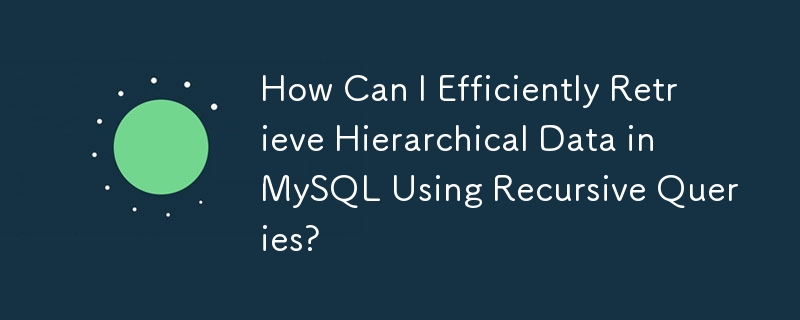 Database
Database
 Mysql Tutorial
Mysql Tutorial
 How Can I Efficiently Retrieve Hierarchical Data in MySQL Using Recursive Queries?
How Can I Efficiently Retrieve Hierarchical Data in MySQL Using Recursive Queries?
How Can I Efficiently Retrieve Hierarchical Data in MySQL Using Recursive Queries?

Background:
Many levels of data structures, such as file systems or tissue structure diagrams, require efficient methods to retrieve data based on parent -child relationships. MySQL provides multiple methods to write recursive queries that effectively traversed these structures.
mysql 8 recursive grammar solution
MySQL 8 introduces recursive with grammar, which greatly simplifies recursive query.
Just replace the value of to the parent node ID you want to retrieve your child node.
WITH RECURSIVE cte (id, name, parent_id) AS ( SELECT id, name, parent_id FROM products WHERE parent_id = 19 UNION ALL SELECT p.id, p.name, p.parent_id FROM products p JOIN cte ON p.parent_id = cte.id ) SELECT * FROM cte;
MySQL 5.x path ID solution parent_id = 19
For example, the table containing path ID may be shown below:
Now, the following inquiries will retrieve all sub -nodes of Category1:
| ID | NAME |
|---|---|
| 19 | category1 |
| 19/1 | category2 |
| 19/1/1 | category3 |
| 19/1/1/1 | category4 |
MySQL 5.X Internal Link variables and self -connection solutions
SELECT * FROM products WHERE id LIKE '19%'
Set the value in <的> as the parent node ID of the node to retrieve its child node.
SELECT id, name, parent_id FROM (SELECT * FROM products ORDER BY parent_id, id) products_sorted, (SELECT @pv := '19') initialisation WHERE FIND_IN_SET(parent_id, @pv) AND LENGTH(@pv := CONCAT(@pv, ',', id))
MySQL provides a variety of methods to write recursive queries to process hierarchical data. The method to choose depends on the specific requirements of the MySQL version and query. @pv := '19'
The above is the detailed content of How Can I Efficiently Retrieve Hierarchical Data in MySQL Using Recursive Queries?. For more information, please follow other related articles on the PHP Chinese website!

Hot AI Tools

Undresser.AI Undress
AI-powered app for creating realistic nude photos

AI Clothes Remover
Online AI tool for removing clothes from photos.

Undress AI Tool
Undress images for free

Clothoff.io
AI clothes remover

AI Hentai Generator
Generate AI Hentai for free.

Hot Article

Hot Tools

Notepad++7.3.1
Easy-to-use and free code editor

SublimeText3 Chinese version
Chinese version, very easy to use

Zend Studio 13.0.1
Powerful PHP integrated development environment

Dreamweaver CS6
Visual web development tools

SublimeText3 Mac version
God-level code editing software (SublimeText3)

Hot Topics
 1377
1377
 52
52
 How do you alter a table in MySQL using the ALTER TABLE statement?
Mar 19, 2025 pm 03:51 PM
How do you alter a table in MySQL using the ALTER TABLE statement?
Mar 19, 2025 pm 03:51 PM
The article discusses using MySQL's ALTER TABLE statement to modify tables, including adding/dropping columns, renaming tables/columns, and changing column data types.
 Explain InnoDB Full-Text Search capabilities.
Apr 02, 2025 pm 06:09 PM
Explain InnoDB Full-Text Search capabilities.
Apr 02, 2025 pm 06:09 PM
InnoDB's full-text search capabilities are very powerful, which can significantly improve database query efficiency and ability to process large amounts of text data. 1) InnoDB implements full-text search through inverted indexing, supporting basic and advanced search queries. 2) Use MATCH and AGAINST keywords to search, support Boolean mode and phrase search. 3) Optimization methods include using word segmentation technology, periodic rebuilding of indexes and adjusting cache size to improve performance and accuracy.
 How do I configure SSL/TLS encryption for MySQL connections?
Mar 18, 2025 pm 12:01 PM
How do I configure SSL/TLS encryption for MySQL connections?
Mar 18, 2025 pm 12:01 PM
Article discusses configuring SSL/TLS encryption for MySQL, including certificate generation and verification. Main issue is using self-signed certificates' security implications.[Character count: 159]
 What are some popular MySQL GUI tools (e.g., MySQL Workbench, phpMyAdmin)?
Mar 21, 2025 pm 06:28 PM
What are some popular MySQL GUI tools (e.g., MySQL Workbench, phpMyAdmin)?
Mar 21, 2025 pm 06:28 PM
Article discusses popular MySQL GUI tools like MySQL Workbench and phpMyAdmin, comparing their features and suitability for beginners and advanced users.[159 characters]
 How do you handle large datasets in MySQL?
Mar 21, 2025 pm 12:15 PM
How do you handle large datasets in MySQL?
Mar 21, 2025 pm 12:15 PM
Article discusses strategies for handling large datasets in MySQL, including partitioning, sharding, indexing, and query optimization.
 How do you drop a table in MySQL using the DROP TABLE statement?
Mar 19, 2025 pm 03:52 PM
How do you drop a table in MySQL using the DROP TABLE statement?
Mar 19, 2025 pm 03:52 PM
The article discusses dropping tables in MySQL using the DROP TABLE statement, emphasizing precautions and risks. It highlights that the action is irreversible without backups, detailing recovery methods and potential production environment hazards.
 How do you create indexes on JSON columns?
Mar 21, 2025 pm 12:13 PM
How do you create indexes on JSON columns?
Mar 21, 2025 pm 12:13 PM
The article discusses creating indexes on JSON columns in various databases like PostgreSQL, MySQL, and MongoDB to enhance query performance. It explains the syntax and benefits of indexing specific JSON paths, and lists supported database systems.
 Explain different types of MySQL indexes (B-Tree, Hash, Full-text, Spatial).
Apr 02, 2025 pm 07:05 PM
Explain different types of MySQL indexes (B-Tree, Hash, Full-text, Spatial).
Apr 02, 2025 pm 07:05 PM
MySQL supports four index types: B-Tree, Hash, Full-text, and Spatial. 1.B-Tree index is suitable for equal value search, range query and sorting. 2. Hash index is suitable for equal value searches, but does not support range query and sorting. 3. Full-text index is used for full-text search and is suitable for processing large amounts of text data. 4. Spatial index is used for geospatial data query and is suitable for GIS applications.



